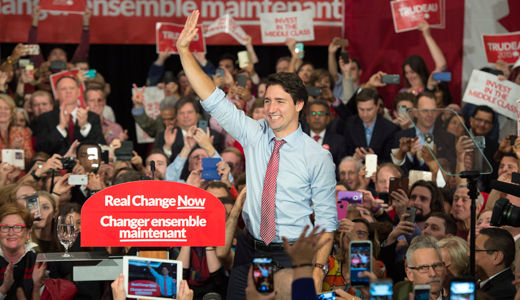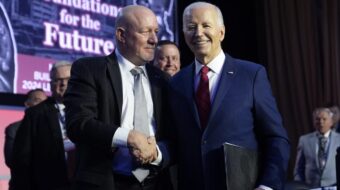
TORONTO – On October 19, Canadians poured into the polls to dump the right-wing Harper Conservatives from power after nearly ten years. The centrist Liberal Party, led by Justin Trudeau, rose from third party status to win a comfortable majority government.
The social democrats of the NDP (New Democratic Party), meanwhile, suffered a major setback and tumbled from first place in the polls at the outset of the election to a distant third when the ballots were finally counted.
By Canadian standards, the election was long, with 78 days of marathon campaigning. The long-sought ouster of Harper represents a major defeat for the most reactionary sectors in Canadian politics, and it is an ideological loss for the forces of neoliberal economics.
Beyond those important aspects, however, the election also holds some useful strategic lessons for American progressives as we head into 2016.
The Campaign
Seeking to preserve his hold on power, Harper ran an ugly campaign. With a recession looming and oil prices dropping, the Conservatives could no longer tout their economic management credentials with the same effect as in elections past.
Of course they tried to replay that message, with a quick ‘balancing’ of the budget just before the election through selling off the government’s GM shares and raiding the surplus reserves of the unemployment insurance system.
Then, in the final weeks, Harper tried stoking racial and religious fears to prop up sagging Tory numbers. With rhetoric that mirrored the anti-immigrant tactics of the Republican Party, it appeared as if he and Donald Trump might have been swapping ideas.
The Conservatives relied on dog whistle calls to ‘old stock Canadians’ and Islamophobic scare tactics about how Muslim women were threatening democracy with their niqabs (traditional dress). In a last desperate measure, even Rob Ford, the former Toronto mayor of crack-smoking fame, was called on to help bring out votes. In all, it was a divisive campaign that showed the worst of what the ultra-right is capable of.
The most important strategic lessons, however, are to be found in an analysis of the NDP and Liberal campaigns. As a rough guide for Americans looking to understand Canadian politics, imagine if the centrist and progressive wings of the Democratic Party were organizationally separated.
The managerial, big business-oriented faction of the Democrats would equate to the Liberals, and the trade union and social movement-based progressive group would be roughly comparable to the NDP.
Now, imagine if liberal Democrats suddenly pledged loyalty to balanced budgets and fiscal discipline while centrist Democrats started promising to increase taxes on the rich and invest in infrastructure. While that is an overly simplistic picture, such a flip-flop of positions is roughly what happened in the Canadian election campaign.
The NDP started in a position of strength. Coming off its historic achievements of 2011, which saw the crushing of the separatist Bloc Quebecois party and the stealing of many Liberal voters, the NDP was in first place when the election was called more than two months ago.
It appeared to be on the verge of achieving its dream of winning the federal government for the first time and displacing the Liberals as the default home for center-left voters.
Party leader Tom Mulcair ran on what was a nominally progressive platform that included a national childcare program, a $15 federal minimum wage, the creation of a prescription drug coverage program, an increase in corporate taxes, opposition to the TPP, and the institution of proportional representation. Though modest in the scale of its proposals, the platform stood squarely in the long social democratic tradition of the NDP and appeared to have broad popular appeal. So what happened?
Among many complex factors, a major one was the way Mulcair tried to work around the fact that the NDP is always between a rock and a hard place when it comes to perceptions about its ability to manage public finances. Though the party has a record of ‘prudent’ fiscal management on the provincial level, there is still a widespread perception of it as spendthrift.
In an attempt to counter this reputation and reach out to non-NDP voters, Mulcair made a promise to balance the budget even if the economy went into recession. He coupled this with a pledge not to touch personal income taxes for the wealthy.
Lessons to take away
Essentially, Mulcair committed the NDP to follow the economic logic of neoliberalism. It was an adoption of the ‘third way’ form of social democracy of the 1990s – but twenty years late! This turned out to be a major misreading of what people were looking for at a time of economic instability. The strategy probably cost the NDP many votes in the urban centers, and it is highly unlikely that the party gained any support among those actually concerned with balanced budgets.
Labor unions largely stuck by the party throughout the campaign, but there was much grumbling among activists about the promises of fiscal discipline. With this blatant abandoning of traditional left strengths – social investment and tackling inequality – the Liberals moved quickly to fill the void and poach disappointed NDP supporters. As one Liberal put it, “The NDP had their foot on our neck and then let go.”
The great success of the Liberal campaign was achieved by presenting the party as a modern progressive force willing to make investments in infrastructure to create jobs and economic growth, raise income taxes on the richest Canadians in order to fund services for those at the bottom, and democratize the political system by bringing in a ranked ballot voting system.
Trudeau managed to transform his own public image from that of an inexperienced son of political royalty to a symbol of a new generation of leadership that contrasted sharply with both Harper and Mulcair. Planting seeds of doubt about the NDP’s ability to fulfill its promises, Trudeau said only the Liberals could bring ‘real change.’
Before getting too excited about the Liberals, there is a need for a dose of reality here. Given that the Liberals were the ones most responsible for the cuts and downsizing of the 1990s, there are reasons to doubt whether Trudeau will be the progressive reformer that he claims.
His party has a notorious habit of signaling left during elections and then turning right once they are in government. This is, after all, the same party that voted in favor of Harper’s anti-Islamic “Barbaric Cultural Practices Act” and Bill C-51, which threatens privacy rights and civil liberties.
That being said, it is still important to look at what can be learned from the Liberals – at least from a campaign perspective. On a rhetorical level, the party managed to effectively challenge the austerity mantra that has dominated governments around the world for more than three decades. With clever and easy to understand ads, the Liberals dismissed the idea that government and public services must be cut during a recession.
Trying to walk up a down escalator in his TV commercial, Trudeau said it symbolized how people have struggled for years but just can’t get ahead in the current economy. He declared, “We can do more for the people who need it, by doing less for the people who don’t.” In effect, the Liberals were mounting a defense of Keynesian economics in a form simplified for mass consumption.
The Liberal campaign demonstrated that it is possible to win on a platform of progressive economics today. They provided proof that the public is interested in an anti-austerity message. The Democratic Party needs to be unafraid of embracing a bold platform of public investment, job creation, and progressive taxation.
The NDP campaign, meanwhile, shows the importance of not misreading the political moment and watering down demands that broad majorities of people may be ready to embrace. It is no longer necessary to tack toward the right in order to win, as Democrats did in the 1990s. After decades on defense, the American left is only beginning to find its footing again in recent years. That has to be helped along, not held back.
And looking at the situation from the perspective of 2016, both campaigns remind us of the importance of left-center unity and of building the broadest possible coalitions of labor, African-American, women, immigrant, youth, and other movements.
Though the Liberals scored a major win in Canada, they did so with only 39.5 percent of votes. The NDP captured 19.7 percent, and the Conservatives still managed to score 32 percent. Had the center-left vote not coalesced around Trudeau in the closing days of the campaign, Harper might very well have been returned to power yet again.
What this means for the U.S. left is that whatever the outcome of the Democratic primary race, it must not be allowed to become a point of division for the broad coalition opposed to the ultra-right Republicans. The Clinton-Sanders competition must not devolve into a split or a dampening of political action once either of these candidates is selected.
American progressives must keep their finger on the pulse of where people are moving. What issues are motivating people into action? What are the demands around which unity can be built? The political atmosphere is shifting leftward. Progressives have to not be too timid in proposing new alternatives and making demands for fundamental change. At the same time, we have to put forward those demands in a way that contributes to building unity and moving ever-greater numbers of people into action.
Photo: Prime minister designate Justin Trudeau speaks to supporters at a rally in Ottawa, Ontario, Oct. 20. Trudeau became Canada’s new prime minister after beating Conservative Stephen Harper. (Adrian Wyld/The Canadian Press via AP)












Comments